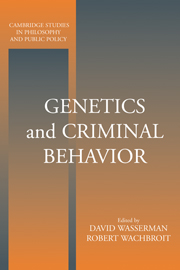Book contents
- Frontmatter
- Contents
- List of Contributors
- Acknowledgments
- 1 Introduction: Methods, Meanings, and Morals
- PART I
- 2 Understanding the Genetics-of-Violence Controversy
- 3 Separating Nature and Nurture
- 4 Genetic Explanations of Behavior: Of Worms, Flies, and Men
- 5 On the Explanatory Limits of Behavioral Genetics
- 6 Degeneracy, Criminal Behavior, and Looping
- 7 Genetic Plans, Genetic Differences, and Violence: Some Chief Possibilities
- PART II
- Index
6 - Degeneracy, Criminal Behavior, and Looping
Published online by Cambridge University Press: 05 June 2012
- Frontmatter
- Contents
- List of Contributors
- Acknowledgments
- 1 Introduction: Methods, Meanings, and Morals
- PART I
- 2 Understanding the Genetics-of-Violence Controversy
- 3 Separating Nature and Nurture
- 4 Genetic Explanations of Behavior: Of Worms, Flies, and Men
- 5 On the Explanatory Limits of Behavioral Genetics
- 6 Degeneracy, Criminal Behavior, and Looping
- 7 Genetic Plans, Genetic Differences, and Violence: Some Chief Possibilities
- PART II
- Index
Summary
This chapter was written for a workshop whose stated topic was criminal behavior. Crime and criminals have been with us always. The idea of criminal behavior has not. In an unproblematic sense of the words, you can engage in criminal behavior without committing a crime. The burglar assembles the tools of his trade and sets out, mask in hand – criminal behavior, we'd unreflectively say – but he falls into bad company on the way, drinks too much, and becomes too drowsy to burgle the mansion. But, of course, that is not what is meant when talk of crime is replaced by a discussion of criminal behavior. We are supposed to think of a tendency or disposition to behave in a certain way. Crimes, we are to imagine, are committed not just (tautologically) by people who behave in a criminal way but by those with a propensity for criminal behavior. In simple statistical modeling, we find the expression “criminal behavior” meaning no more than criminal acts – offences against the criminal law – of any type: embezzlement, burglary, assault, rape, murder, bank card fraud (e.g., Rowe, Osgood, and Nicewander 1990). In that literature it appears that “acts” could be substituted for “behavior” without change of intended meaning. (My burglar who fell asleep before committing an offence did not engage in criminal behavior.) But in sociological, psychological, and genetic work, the word “behavior” is treated more seriously. Most often violent criminal behavior is in view, and not, for example, bank card fraud.
- Type
- Chapter
- Information
- Genetics and Criminal Behavior , pp. 141 - 168Publisher: Cambridge University PressPrint publication year: 2001
- 8
- Cited by



